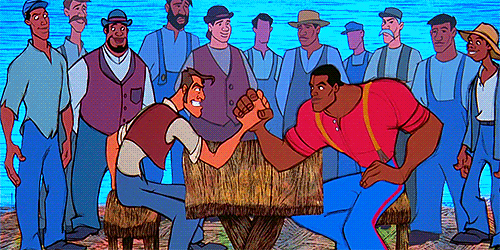 Photo from http://www.intanibase.com/shorts.aspx?shortID=713#page=general_info
Photo from http://www.intanibase.com/shorts.aspx?shortID=713#page=general_info
It is important to note that historian Scott Nelson discusses the legend of John Henry, a powerful black man who competed against a steam-powered hammer and died after his victory.[1] This myth could be associated with a true story of convicted laborer, who was another John Henry.[2] John Henry was a victim of the black codes when racial discrimination laws in Southern states that targeted newly freed slaves post-Civil War. He was arrested because of “housebreaking and larceny” with a10-year sentence and became a convict laborer who was leased to the C&O Railroad by the Virginia Penitentiary. [3] There is always a gap between history and legend. However, the answer to the question of “who was John Henry” seems less essential, because John Henry already transformed from a man to a myth and became an iconic figure. John Henry was an icon of African American folk hero, who portrayed the courage of a common man to challenge a powerful opponent through sweat and self-sacrifice. King also illustrated this iconic figure, as he demonstrated unyielding persistence and a fighting spirit under racial discrimination that was widespread in the legal system in the American society in 1960s.

Photo from https://tinyurl.com/ybycknnt
In the Letter from Birmingham Jail, King emphasized that fighting for racial equality is a battle between all African Americans and the segregated social system in the United States. King believed that it is essential to race against time to lead the African American community fighting the battle against discrimination because “justice too long delayed is justice denied.” [4] Similar to the myth of John Henry in which he seizes every minute and second to compete with a mechanical drill that made him an icon of a courageous man against a machine, King is an icon of a brave man going against the social system as he competes against time unremittingly to challenge racial discrimination that was established in American society for hundreds of years.
Although the 14th Amendment, ratified in 1868, gave African Americans citizenship and equal protection under the law and the 15th Amendment in 1870 granted Blacks the right to vote, African Americans remained far away from obtaining equality. Southern states established “Jim Crow” laws in the late 19th century, which segregated African Americans from whites in all public facilities.[5] Even though the roots of racism deeply shaped the American society, it did not prevent King from challenging inequality that was established in America since its founding. In Martin Luther King: “Now is the time,” author Angela Herbert demonstrates the struggles of King as a civil rights activist. Not only did King face intense pressure, he was also “arrested 30 times and imprisoned along with a number of students and fellow colleagues as a result of their engagement in non-violent protests.”[6] The oppression faced by King did not stop him from challenging racism; he contributed to unite the African American community through his public speeches and literature work.

Photo from http://hero.wikia.com/wiki/John_Henry
Like John Henry in the legend, who sacrificed his life and illustrated a heroic fighting spirit, King made powerful speeches that fiercely criticized racial discrimination and his assassination shaped him as an epic martyr who devoted his life to push an important step that catalyzed the Civil Rights Movement against racism. Literary critic Michiko Kakutani emphasizes that King “knew how to read his audience and react to it.” [7] King used the power of words with vivid imagery and strong emotion to give African Americans courage and hope. Today, many children watch the Disney version of John Henry and they might fall into sadness when they see John Henry die after his victory. King’s powerful speeches evoke the same emotions and are able to bring people to tears. King united African Americans and challenged the formidable racism in American society, which made him an iconic hero.
Similar to the myth of John Henry, hammering again and again to compete with a massive machine, King attacked the intensive racism that had deep roots in this country through word by word in his speeches. Even though John Henry and King faced mighty opponents, their indomitable fighting spirit demonstrate an iconic American spirit of struggle in which a victim in predicament could become a hero through persistence and self-sacrifice for a greater cause.
[1] Scott Nelson, “Who Was John Henry? Railroad Construction, Southern Folklore, and the Birth
of Rock and Roll,” Labor: Studies in Working-Class History of the Americas,Vol. 2. No. 2 (2005): 53.
[2] Ibid., 66.
[3] Ibid.
[4] Martin Luther King Jr., “Letter from a Birmingham Jail [King, Jr.],” Africana Studies at
University of Pennsylvania, April 16, 1963,
https://www.africa.upenn.edu/Articles_Gen/Letter_Birmingham.html, accessed February 14, 2018).
[5] “Civil Rights Movement,” Black History, HISTORY.com,
http://www.history.com/topics/black-history/civil-rights-movement, (accessed February 14, 2018).
[6] Angela Herbert, Martin Luther King: “Now is the time”( London: Springer International
Publishing, 2016), 10.
[7] Michiko Kakutani , “The Lasting Power of Dr. King’s Dream Speech,” New York Times,
August 27, 2013, http://www.nytimes.com/2013/08/28/us/the-lasting-power-of-dr-kings-dream-speech.html (accessed February 14, 2018).
